Characteristics of children with substantiated abuse or neglect
On this page:
- Younger children were more likely to be subjects of substantiations
- Types of abuse or neglect differed between boys and girls
- Higher rates of substantiations in geographically remote areas
- Substantiations more likely in lower socioeconomic areas
- Aboriginal and Torres Strait Islander children in substantiations
- References
Younger children were more likely to be subjects of substantiations
Age is one of the factors that child protection workers consider when determining the time taken to respond to a notification, the type of response, and whether a notification will be substantiated.
In 2020–21, children in younger age groups were more likely to be the subjects of substantiations than those in older age groups.
Infants (children aged under one) were most likely (17 per 1,000 children) to be the subjects of substantiations, and those aged 15–17 least likely (5 per 1,000). This pattern was consistent across jurisdictions (Table 3.3).
| State or territory | Less than one (number per 1,000) | 1 to 4 (number per 1,000) | 5 to 9 (number per 1,000) | 10 to 14 (number per 1,000) | 15 to 17 (number per 1,000) | 0 to 17 (number per 1,000) | All children (number per 1,000) |
|---|---|---|---|---|---|---|---|
| NSW | 14.4 | 10.0 | 9.0 | 10.1 | 7.2 | 9.6 | 10.1 |
| Vic | 26.4 | 12.2 | 10.8 | 11.0 | 6.5 | 11.3 | 11.3 |
| Qld | 7.6 | 5.1 | 5.0 | 5.3 | 3.0 | 4.9 | 5.4 |
| WA | 11.3 | 8.2 | 7.2 | 5.9 | 3.1 | 6.6 | 7.0 |
| SA | 24.3 | 8.2 | 6.3 | 5.0 | 2.5 | 6.6 | 6.6 |
| Tas | 5.5 | 3.6 | 3.4 | 2.8 | 2.4 | 3.2 | 3.6 |
| ACT | 5.5 | 3.6 |
3.4 |
2.8 | 2.3 | 3.5 | 3.5 |
| NT | 63.8 | 26.6 | 22.7 | 25.9 | 17.2 | 26.0 | 26.0 |
| Total | 16.6 | 9.2 | 8.2 | 8.4 | 5.3 | 8.5 | 8.8 |
Notes:
- Data presented in this table are not comparable across jurisdictions due to differences in the way jurisdictions collect and report data on notifications, investigations and substantiations. See Appendix A for more information.
- Unborn children might be covered under child protection legislation, so are included in this table. But they are excluded in rate calculations for the ‘less than one’ and ‘0–17’ categories. Unborn children are included in the ‘All children’ rates.
- ‘All children’ includes children of unknown age.
- Finalised investigations, and thus substantiations, refer only to cases that were notified during the reporting period, and finalised by 31 August. This excluded finalised investigations that were notified in a previous reporting period.
- See Technical notes for the method used to calculate rates.
Source: AIHW Child Protection Collection 2020–21.
Types of abuse or neglect differed between boys and girls
Slightly more girls (25,100) than boys (23,600) were the subjects of substantiations (Supplementary table S3.5).
A higher proportion of girls (14%) were the subjects of substantiations for sexual abuse than boys (5.8%) (Figure 3.5). This is consistent with recorded crime statistics for sexual assault (ABS 2020).
In contrast, boys had slightly higher proportions of substantiations for emotional abuse, neglect and physical abuse (Figure 3.5).
Figure 3.5: Children who were the subjects of substantiations of notifications, by primary type of abuse or neglect and sex, 2020–21 (per cent)
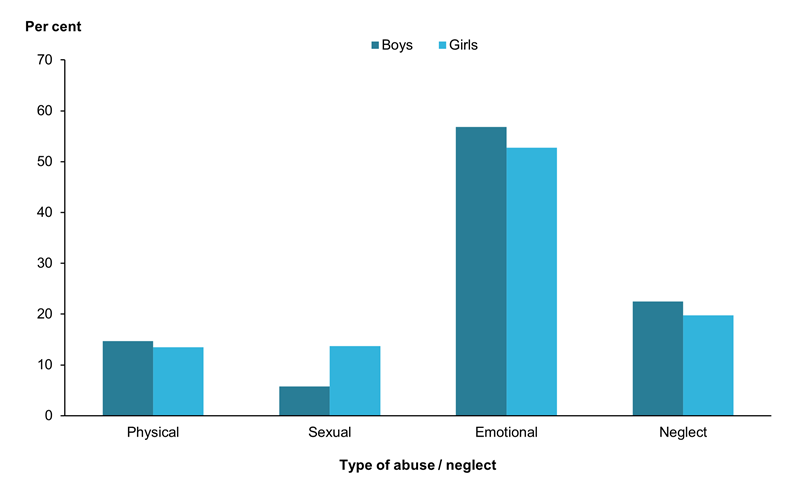
Note: Only the type of abuse that is most likely to place the child at risk or be most severe in the short term is reported for the first substantiation in the reporting period.
Chart: AIHW.
Source: Supplementary data table S3.5, AIHW Child Protection Collection 2020–21.
Higher rates of substantiations in geographically remote areas
Children from geographically remote areas had the highest rates of substantiations – children from Very remote areas (26 per 1,000 children) were more than 3 times as likely as those from Major cities (7 per 1,000) to be the subject of a substantiation (Figure 3.6; Supplementary table S3.7b).
Figure 3.6: Children who were the subjects of substantiations, by remoteness area, 2020–21 (rate)
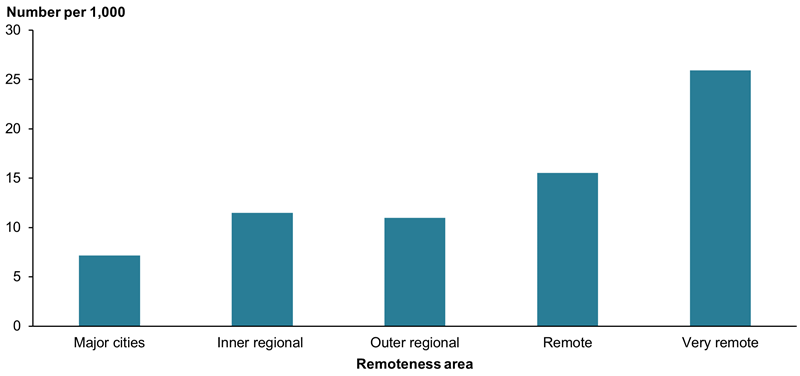
Note: See Technical notes for more information on the calculation of remoteness areas.
Chart: AIHW.
Source: Supplementary data table S3.7b, AIHW Child Protection Collection 2020–21.
Substantiations more likely in lower socioeconomic areas
Children who were the subjects of substantiations were more likely to be from the lowest socioeconomic areas (35% or 16,800 in the lowest socioeconomic area compared with 7.1% or 3,400 in the highest) (Figure 3.7; Supplementary table S3.8).
Figure 3.7: Children who were the subjects of substantiations, by socioeconomic area, 2020–21 (per cent)
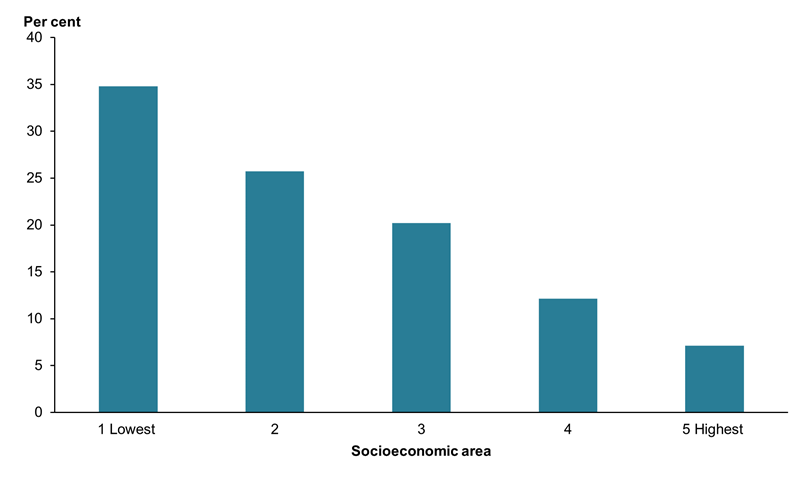
Note: See Technical notes for more information on the calculation of remoteness areas.
Chart: AIHW.
Source: Supplementary data table S3.8, AIHW Child Protection Collection 2020–21.
Aboriginal and Torres Strait Islander children in substantiations
In 2020–21, 14,600 Indigenous children were the subject of a substantiation. This is a rate of 43 per 1,000 (Figure 3.8).
The reasons for the over-representation of Indigenous children in child protection substantiations are complex. Factors impacting over-representation include:
- the legacy of past policies of forced removal
- intergenerational effects of previous separations from family and culture
- a higher likelihood of living in the lowest socioeconomic areas
- perceptions arising from cultural differences in child-rearing practices (HREOC 1997).
Figure 3.8: Children who were the subjects of substantiations of notifications received during 2020–21, by Indigenous status and state or territory (rate)
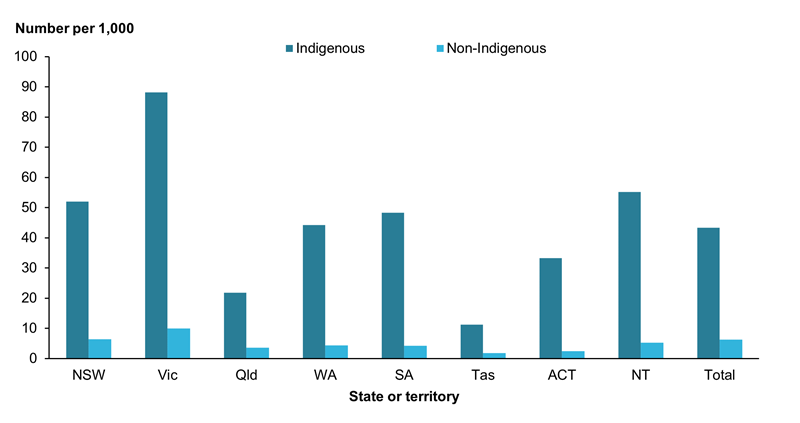
Notes:
- Data presented in this figure are not comparable across jurisdictions due to differences in the way jurisdictions collect and report data on notifications, investigations and substantiations. See Appendix A for more information.
- See Technical notes for the method used to calculate rates.
Chart: AIHW.
Source: Supplementary data table S3.9, AIHW Child Protection Collection 2020–21.
Emotional abuse was the most common primary type of substantiated abuse for Indigenous children (48%) followed by neglect (31%), physical (14%) and sexual (7.3%) abuse (Figure 3.9).
Figure 3.9: Children who were the subject of substantiations of notifications, by Indigenous status and primary type of abuse or neglect, 2020–21 (per cent)
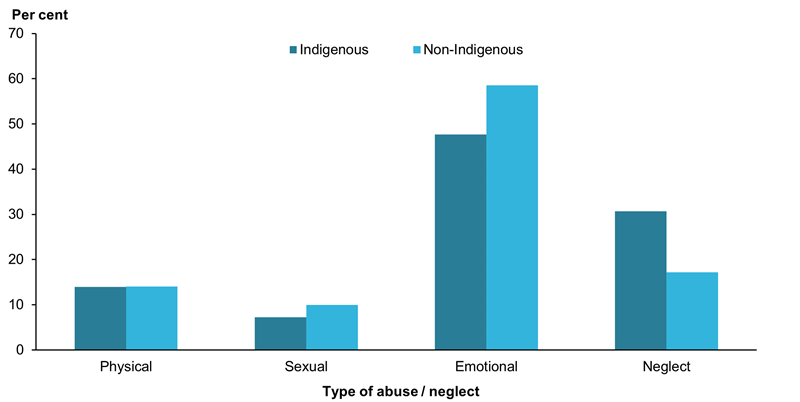
Note: For each child, the type of abuse/neglect reported is the type identified for their first substantiation in the reporting period. Where multiple types of abuse were reported in the same substantiation, the data reflect the primary type of abuse, that is, the one most likely to place the child at risk or be most severe in the short term.
Chart: AIHW.
Source: Supplementary data table S3.10, AIHW Child Protection Collection 2020–21.
Indigenous children from the lowest socioeconomic areas were more likely to be the subjects of substantiations. Of the 13,900 Indigenous children who were the subjects of substantiations and could be mapped to a socioeconomic area, about 42% (5,900) were from the lowest socioeconomic area, compared to 3.9% (548) who were from the highest (Supplementary table S3.8).
References
For a full list of references, go to References.


